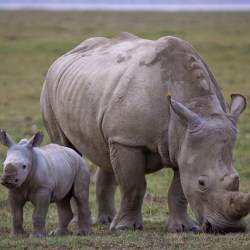Attenborough’s Extinction: The Facts

September 2020 saw the release of the BBC’s film Extinction : The Facts, presented by David Attenborough. The film confronts biodiversity destruction and what that means for of us and what needs to change.
Departure from the past
It is a departure from the past format of Attenborough’s documentaries. Previously there was a sense of distance between us and the natural world. Nature was showcased as something we can marvel at but as a result we don’t necessarily feel part of. The latest film is different, it talks honestly about the state of the natural world and gives the cold hard reality or habitats being taken over by agriculture and urbanisation.
In the early stages of the film it introduces the last two remaining northern white rhinos, a mother and daughter. Once these two have died the species will be extinct. However, the films focus is greater than a single species dying out. It highlights the inter connection between all living things and makes a point of putting us within that worldwide ecosystem and shows how reliant we are on it.
One million species now face extinction…that is one million out of the eight million species on earth according to the scientists involved in the film. Extinction is a natural process, species naturally decline, however it is the rate at which such a broad group of species is declining that is so alarming. Usually if nature runs its course a species might die out over millions of years versus tens of years that we are now encountering.
Biodiversity loss link to pandemic
One element of the film that is extremely topical is the link between biodiversity loss and disease. The contentious wildlife trade brings certain animals in to unnaturally close contact, and gives a chance for virus’s to jump between species. In addition, interference with food chains, with the removal of large predators in certain habitats has given rise to an increase in virus carrying animals such as rodents and bats. The long and short of it is that humans have had a catastrophic impact on biodiversity in such a way that has made pandemics more likely.
Biodiversity loss is not a new thing. It has been known and discussed for years, so why has nothing been significantly done? Is it that the western world has not connected the issue to our consumerism? Consumption of the worlds resources is the critical issue in rich countries. Reducing the wealthiest countries consumption is vital. Forty years ago we consumed less, but we were no less happy so it is certainly possible to dial it back.
Accountability needed for consumer impact
In addition, the film points out that we need to be accountable for environmental damage. In simple terms, the business world lies at the heart of our consumer habits, but businesses are not held accountable enough for their environmental impact. They need to have a conscience, they can’t degrade the environment for free, there has to be a cost.
The film is not all doom and gloom, there is some optimism. For example, the Rwandan gorilla’s that Attenborough visited 40 years ago are now on the up in terms of numbers, but at the time of his original visit it was believed they were facing extinction. So we can assist with turning things around…but it is up to us. The film makes it very clear, we are at a critical cross roads. For any environmental skeptics it should be compulsory viewing.



